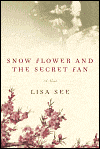
You’ll be mesmerized by this novel about the women’s secret “inner world” in 19th century China, a world that hadn’t changed in a thousand years. It is the world of women who bound their daughters’ feet and spent their lives in upper rooms with only lattice windows to let them see the men’s “outer world.” Reading this novel will also break your heart. The narrator is Lily, born the second daughter of a poor farmer in a poor district. Lily’s family is visited by a diviner and a matchmaker, and at age six, Lily is seen to have perfect feet, perfect, that is, to become “golden lilies.” The matchmaker finds Lily not only a husband but also an “old same,” or life-long female friend. Old same relationships are not sexual and there is only one tiny almost erotic scene; our old sames are the women we depend on to help us survive in our lives. (The old same is perhaps analogous to our truest girlfriend.) Lily’s old same is Snow Flower, the daughter of a prosperous family that has fallen into poverty, though Lily and her family do not learn this until the girls have been old sames for a decade. Thanks to her “golden lily” feet, Lily marries well, becomes Lady Lu, and lives into her eighties (thirty or forty years longer than most women lived at the time). She become an exceedingly traditional Chinese woman, and because of her pride she makes grave mistakes in her life. As she tells us over and over again, she is writing her life story to atone for those mistakes, the worst of which concerns Snow Flower. What was life like for women in China before the Maoist revolution? Daughters were “worthless branches” who were “married out” of the natal village (the practice of exogamy). Marriages were arranged by matchmakers and the girl did not actually go to live with her husband’s family until she was pregnant. Her only goal in life was to bear sons. Her duties were to obey her husband, her mother-in-law (and mothers-in-law could be cruel), and her oldest son. After their feet were bound (at age six or seven), girls spent the rest of their lives in the women’s upstairs rooms sewing, weaving, gossiping, and being virtual slaves. Their mothers told them that the pain they endured would give them a better life. When things got too hard, the women prayed to an unnamed goddess whom we recognize as Kwan Yin. The “secret fan” of the title is the fan upon which Lily and Snow Flower write poems to each other using nu shu, the secret language of women that is said to have been developed a thousand years ago. Nu shu—the only way women had to communicate with their friends—used about a thousand of the characters of the Chinese “alphabet,” but the characters were written or embroidered as if in italics and no nu shu statement was ever direct or plain. Meaning depended entirely on context and inference. In her author’s note, Lisa See tells how she visited the actual setting of the book while she was writing it. She met an aged Chinese woman named Yang Huanyi, who was the last surviving original nu shu writer. Yang Huanyi taught See the sorrowful songs the women in the novel sing to each other, the process of quilt-making, how to make lotus shoes for bound feet (which are three inches long), and how the women survived. Snow Flower and the Secret Fan, See tells us, is about what it means to be a woman. “Yes, our lives are completely different from those lived by the nu shu writers, but inside we are the same. We want people to hear our thoughts, appreciate our creativity, and feel empathy for our emotions.” Whether women live in China, Afghanistan, Sudan, or the United States, “we long for long, friendship, happiness, tranquility, and to be heard” (p. 265). It’s good to learn how the women of other cultures have lived. This is a novel to read with your heart as well as your eyes. ~reviewed by Barbara Ardinger, Ph.Dby Lisa SeeRandom House, 2005pp. 269 pages, $13.95
